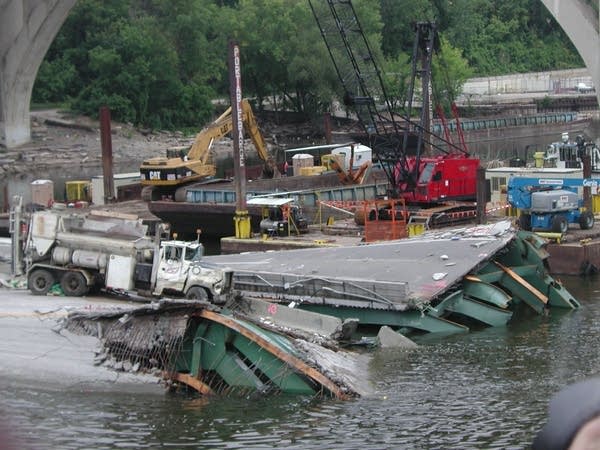Pawlenty bonding proposal includes $225 million for bridges
Go Deeper.
Create an account or log in to save stories.
Like this?
Thanks for liking this story! We have added it to a list of your favorite stories.

Transportation projects make up more than a third of Pawlenty's total bonding proposal. There's money included for local roads, a new MnDOT building in Mankato and about half of what supporters want to advance the Central Corridor light rail project.
But the biggest slice of the bonding pie goes toward local bridges. Pawlenty said the $225 million is a record amount, and will accelerate work on a priority issue.

"This will replace 600 local bridges in the state of Minnesota," he said. "That's a needed improvement and a needed advance for transportation infrastructure in the state of Minnesota. That would be about a four-fold increase in local bridge funding as compared to any bonding bill in the history of the state."
Pawlenty said his proposal for $965 million in general obligation bonding meets the state guideline of keeping new debt at 3 percent of expected state revenues. In a message directed to DFL leaders in the House and Senate, Pawlenty said he won't sign a bonding bill that exceeds his total.
Turn Up Your Support
MPR News helps you turn down the noise and build shared understanding. Turn up your support for this public resource and keep trusted journalism accessible to all.
"You know the dance, normally we'd come out and we have a lower number, they have a higher number, and we try to meet in the middle and there are a lot of gyrations about that," he said. "Now we're just saying we all know where we're going to end up. So we don't need to be fusing about the size of the bill. We can be talking about what's in the bill."
DFL lawmakers were quick to applaud the size of the package. But they were critical of its contents.
Sen. Keith Langseth, DFL-Glyndon, chairman of the Senate capital investment committee, said the governor's $225 million bridge proposal is politically motivated. Langseth said city and county officials, who would have to pay a local share of bridge projects, were asking for only $70 million.

"What he's up to is trying to cover for two things: a bridge that went down, and the fact that he vetoed a comprehensive transportation bill that passed by more than two thirds of both houses," he said. "That's what he's trying to cover up for."
Langseth favors the passage again of a separate transportation funding bill with a gas tax increase to address bridge and road projects, even though Pawlenty's support is uncertain. He says that would make more bonding money available for colleges and universities, as well as some important regional public works projects.
Langseth's House counterpart, Rep. Alice Hausman, DFL-St. Paul, agreed. Hausman said higher education bonding results in jobs statewide.
"If you can imagine every campus all across the state suddenly being able to repair its building and windows and roofs and so forth," she said. "And so, carpenters go to work, electricians go to work. We see this year, this bonding bill, as an economic stimulus package."
Pawlenty described his proposal as large, but fiscally responsible. The plan would fund a dozen higher education projects.
--The University of Minnesota and Minnesota State Colleges and Universities system would each get $129 million for repairs and construction.
--There's $40 million for the Duluth Entertainment and Convention Center.
--The plan includes $35 million for improvements to the Minneapolis Veterans Home
--and $30 million for infrastructure related to the Minnesota Steel project near Nashwauk.
Lawmakers will likely see a separate bonding proposal in the coming weeks for a new state park at Lake Vermilion.
Pawlenty did not include the land purchase or development costs in his package, because he said negotiations with U.S. Steel are still underway. Pawlenty said he did not want to reveal the price state officials are willing to pay until the deal is complete.



